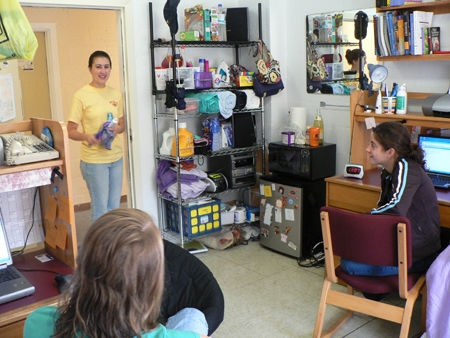You have /5 articles left.
Sign up for a free account or log in.

A dorm room at the University of Virginia
U. of Virginia
It’s the question that everybody wants an answer to: Why is college tuition so high?
There's no shortage of potential culprits. At various times in the past few years, areas such as intercollegiate athletics, decreased state support, federal aid programs, the price of highly skilled labor and the growth of administrative bureaucracy -- among others -- have all come in for a share of the blame.
But sophisticated analyses of the revenues and costs associated with public higher education institutions have been few and far between, complicating efforts to control both cost (what institutions spend) and price (what colleges charge students). And that makes the initiative launched by Virginia's Joint Legislative Audit and Review Commission, an oversight agency that evaluates other state agencies and programs, interesting.
Over the next two years, the commission, at the request of state lawmakers, plans to analyze in depth how expenses at the state's public universities have changed over the past few decades, an endeavor that could result in new ways to control costs and prices, both in the state and nationwide. And the commission's first report, released this month, hints at one area that will be explored in depth in subsequent reports -- auxiliary services, including housing, dining and intercollegiate athletics.
“During the last decade, total spending per student (accounting for inflation) increased about 2 percent at Virginia’s six research institutions, and about 11 percent at Virginia’s other nine institutions,” the report states. “Spending on auxiliary enterprises funded by students was the largest driver of these spending increases. Auxiliary enterprise spending per student, after inflation, increased $821 at Virginia’s six research institutions and $906 at the other nine non-research institutions.”
That finding has the potential to play into an oft-repeated narrative about colleges spending their money on nonessential facilities and services -- climbing walls, lazy rivers and lavish dorms -- instead of classrooms and instructor salaries. The finding could be fodder for another round of political attacks on the state’s universities and could hinder their ability to raise revenues through increased state appropriations or tuition hikes.
Higher education finance researchers say the picture is more complicated than this first legislative report indicates, and that attributing the increase to auxiliary services understates the complicated factors playing into the rising cost of education, both to institutions and students.
Accurately accounting for what’s driving increased costs in higher education is proving to be one of the major challenges to controlling costs. University revenues come from myriad sources including state appropriations, tuition revenue, auxiliary services, fund raising and investment returns. For research universities, federal funding and corporate partnerships can often make up a large chunk of revenues. Some of those revenues are tied to particular expenses such as research projects, while others are not, further complicating the accounting.
“Breaking apart the production process into little bits and pieces often serves political ends more than analytic ends,” said David Feldman, an economist at the College of William & Mary who co-wrote Why Does College Cost So Much? (Oxford University Press, 2010). “How does one neatly carve out research as a cost? Is the library part of that research cost, or should 52.4 percent of it be allocated to instruction? What if research funds itself through outside grant support? Would an increase in spending on that sort of research be a bad thing? Sometimes the details are not enlightening.”
Virginia officials say they recognize the potential for misuse of the first report's findings, and that subsequent reports will provide a more comprehensive portrait of higher education finance. “What we were trying to do in this first report is look at the data and begin to get a sense of where we need to look in our subsequent work,” said Justin Brown, senior division chief at the Virginia commission and project leader.
Over the course of five reports to be issued over the next two years, Brown said, the commission plans to explore a range of issues related to auxiliary, administrative, research and instructional costs. Those include, but aren't limited to, teaching loads, faculty research, facilities usage, technology, outsourcing and procurement.
The reports could prove to be an important contribution to the cost debate – similar to the consultant reports commissioned by several research universities in the wake of the recession – if they can identify real cost drivers and savings.
But higher education finance researchers were skeptical of the value that this first report adds to the conversation. Much of the report is devoted to trends over the past few decades that have been well-documented, including the decline in state support for public higher education, the increase in tuition prices, the increase in loan burdens and the increase in the share of family income required to pay for higher education.
The legislative report found that over the past two decades, total spending at Virginia’s 15 public universities grew from about $2.6 billion to about $6 billion. Since enrollment has also grown over that period, the per-student increase is not as dramatic, but has still grown, with the amount of that spending that comes from the state declining.
A larger share of revenue comes from tuition dollars than in the past. The report found that tuition and fees, plus charges for student housing and dining, have increased 150 percent on average between 1992-93 and 2011-12.
Where the report tries to address the cost drivers, researchers said, it fails to make meaningful contributions to the debate. The report finds that about two-thirds of university expenses are tied to non-instructional spending, with the largest chunk of that coming from auxiliary services.
“In most cases, Virginia’s 15 colleges and universities spend a higher portion of their total spending on auxiliary services than other institutions,” the report states.
Donna Desroches and Rita Kirschstein at the Delta Cost Project, now housed at the American Institutes of Research, found the focus on auxiliary services to be strange, given the fact that many auxiliary enterprises are profit-making. “Except for a few exceptions, at almost all institutions auxiliary services are bringing in more revenue than is being spent,” Desroches said.
Those institutions that spend a larger chunk of their budget on instruction are often simply not providing such services, said Robert Archibald, Feldman's co-author and an economist at William & Mary. Virginia Commonwealth University, George Mason University, and Old Dominion University, which the report highlights for spending a greater share of their budgets on instruction than their Carnegie classification counterparts do, are all located in urban areas and have large numbers of students living off-campus.
“The [report] does not show that they are really devoting more of their budgets to instruction as much as it shows that they are devoting less of their budgets to housing students, and feeding them for that matter, because they have lots of part-time students,” Archibald said.
Attending such institutions might result in a lower bill in tuition and fees, but students must still pay for housing, food and transportation elsewhere.
Officials at the University of Virginia said they have not looked at the report and could not comment on its findings. Officials from the College of William & Mary did not return a request for comment.
The report seems likely to spark discussion about what auxiliary services the state and students should be spending money on. At a hearing this month on the report, Senate Majority Leader Thomas K. Norment Jr. asked whether any determination could be made about what percentage of auxiliary spending was "dedicated to intercollegiate athletics." The report’s author said that would be explored in a later report.
"We as policy makers are going to have to start taking a different perspective on how we fund public education in Virginia,” Norment said after the hearing, according to The Richmond Times-Dispatch.




